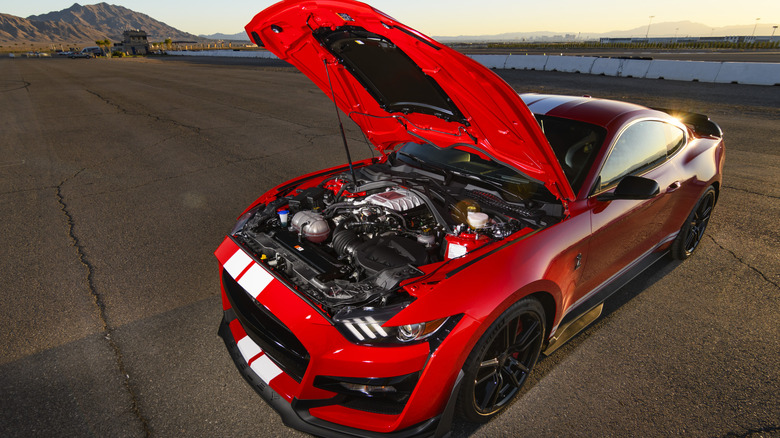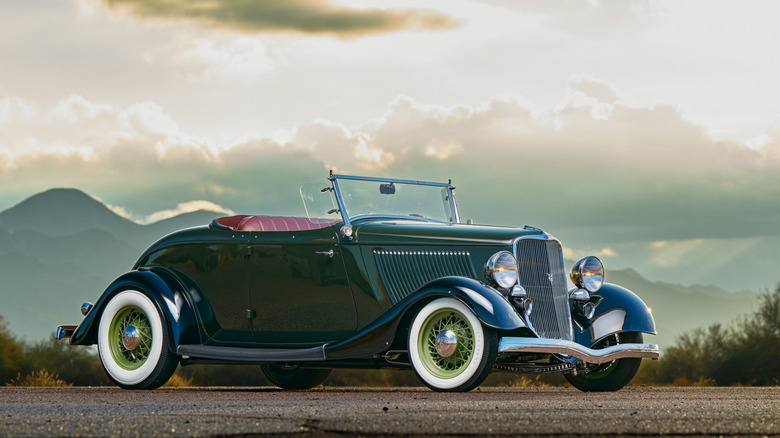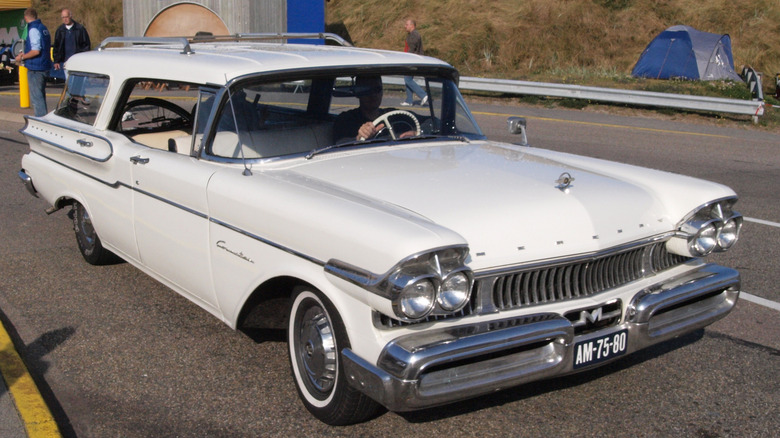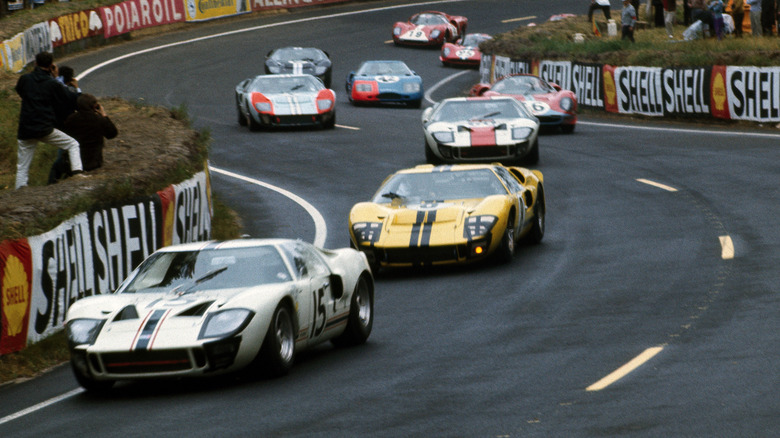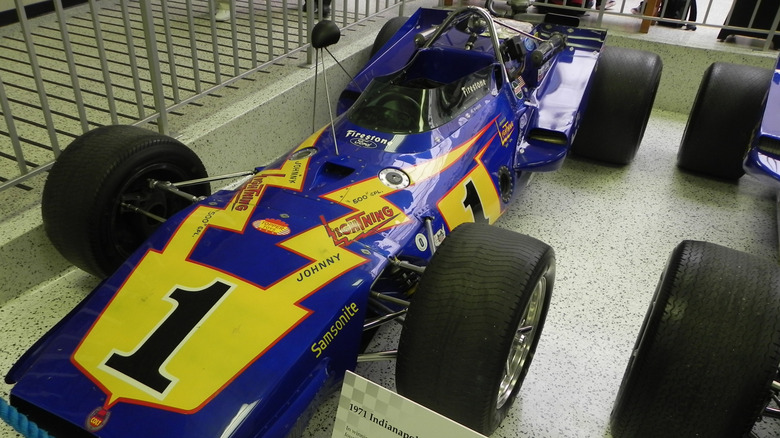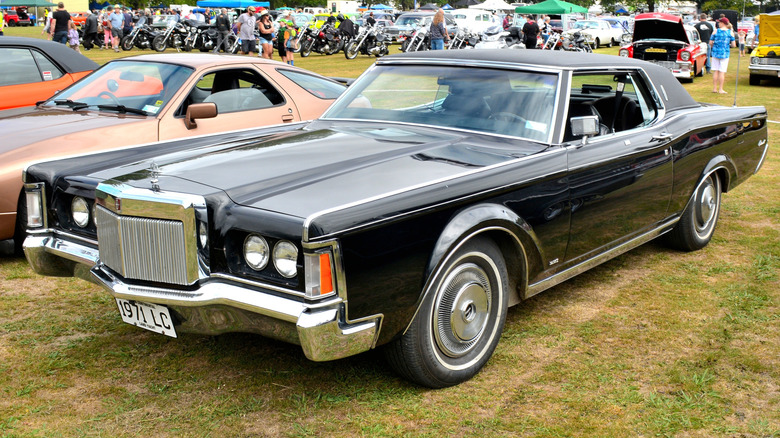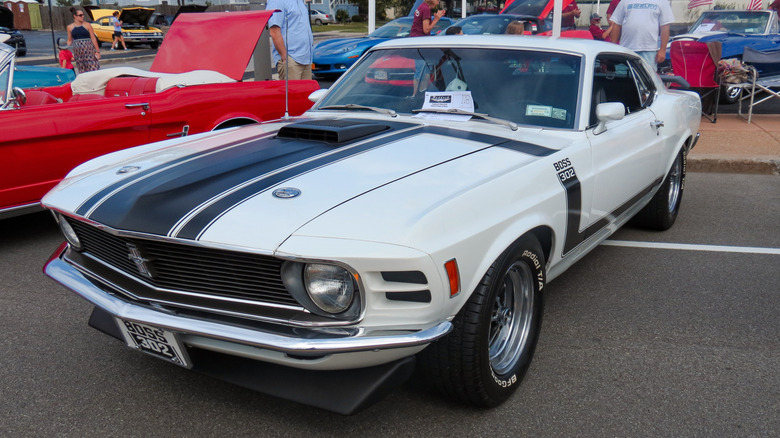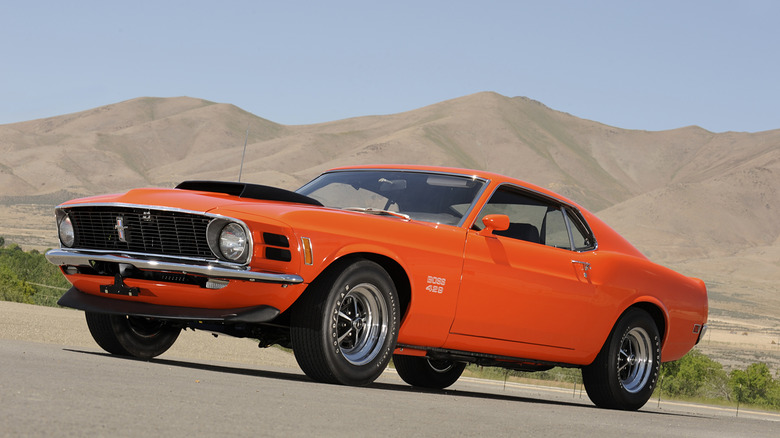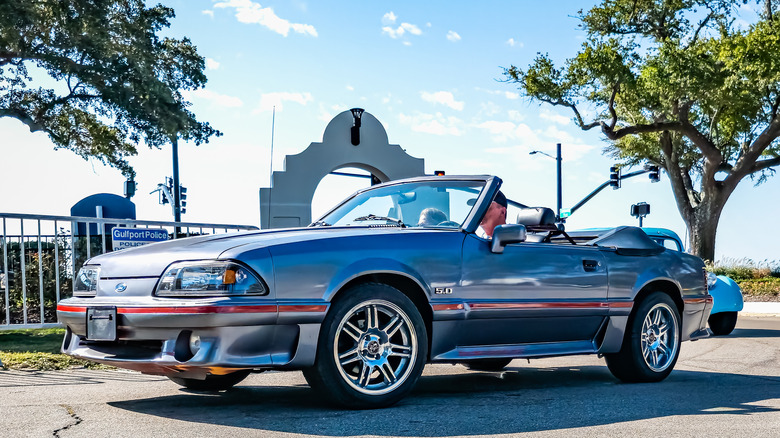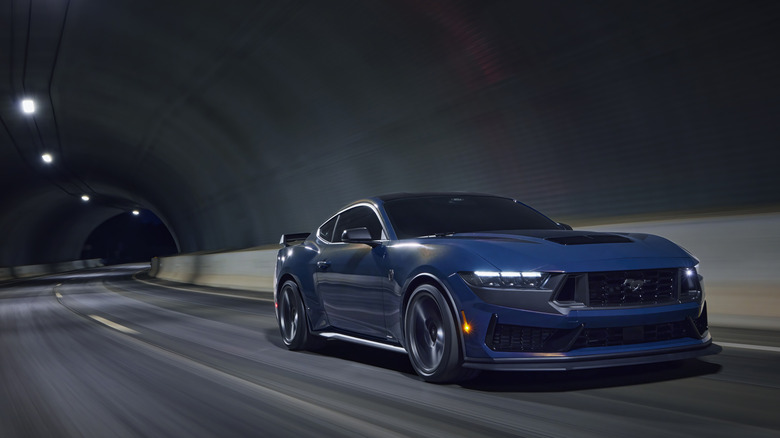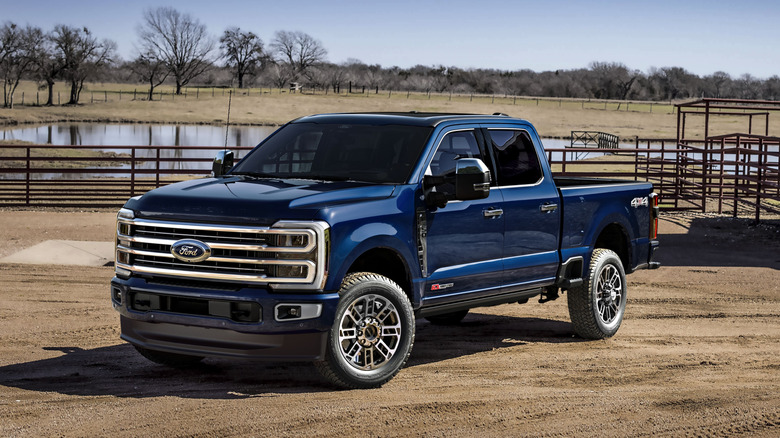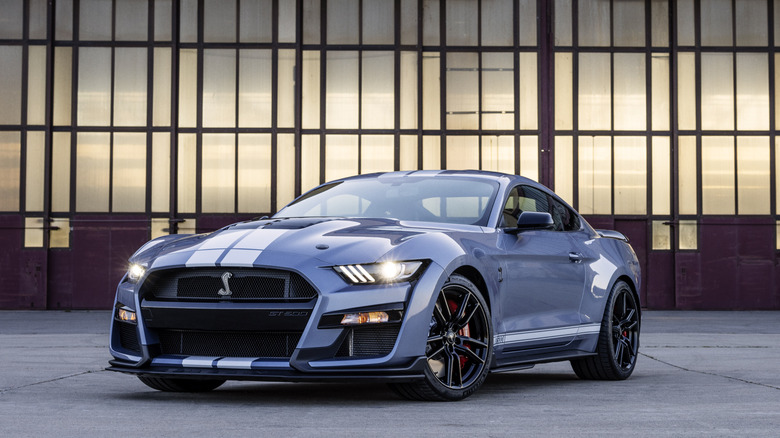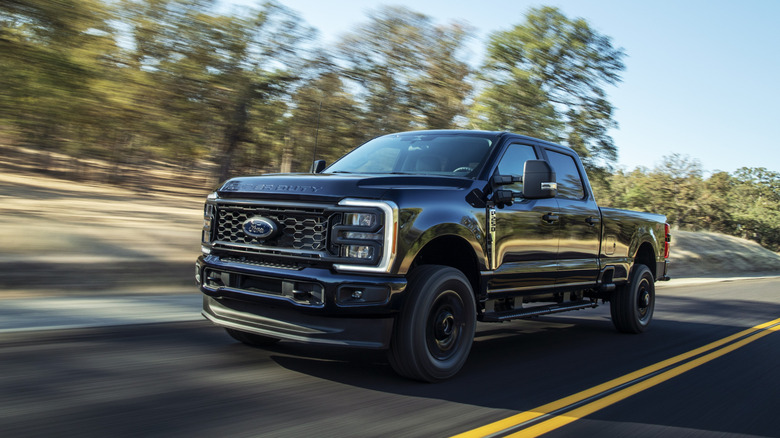12 Of The Greatest Ford V8 Engines Ever Made
Ford is the company that brought us mass manufacturing and with that, more affordable cars. It's safe to say that company truly popularized the car as a form of transport for everybody. However, since the 1930s, the Blue Oval has been synonymous with the V8 engine. Capable small blocks that won numerous races. Big-block beasts with power to spare. Turbodiesels that could tow any trailer. Ford truly has had a V8 engine for everyone for almost a century now.
But which Ford V8 engines are the greatest? Deciding on that is often an entirely subjective matter, as each engine has its application. In this piece, I'll give you my perspective on the Ford V8 matter. I've been writing about, testing, and reviewing cars for over 15 years, and crucially, closely followed the development of the American automotive industry. What follows is a chronological list of Ford's greatest V8s, containing engines of various types and designs. Enjoy!
Ford Flathead V8 (1932 to 1953)
Today, engine tuning is an integral part of automotive culture. Some engines have even become mythical for their flirtation with the aftermarket. And it all started with Ford's Flathead V8.
Designed as a more affordable V8 for the masses, the Flathead quickly became a staple among hot rodders. Official or unofficial, the Flathead was a part of it. It was very reliable and easy to tune. What made the Flathead V8 special, though, is that it made Americans love V8s.
The Flathead V8's big advantage, at least at the time, was its simplicity (not that you'd expect anything different from Henry Ford's company). Ford engine designers Carl Schmaltz, Ray Lard, and Mil Zoerlein made a simple flat engine head that only housed the spark plugs — no overhead camshaft here. The valves were positioned next to the cylinder on the engine block, and the intake manifold was positioned between the cylinder banks. All these decisions significantly lowered the production cost, putting the Flathead V8 under the right foot of more people.
If the engine had a main drawback, it was that the design heavily restricted airflow and only allowed low compression ratios. What's more, increasing the compression ratio meant even more restricted airflow. For context, the first 3.6-liter Flathead V8 made only 65 hp, with a compression ratio of 5.5:1. Even the last 1953 3.9-liter unit, had a modest compression ratio of 7.2:1 and produced 110 hp. Still, this wasn't enough to hurt Flathead's unmatched hot rod legacy.
Ford MEL (1958 to 1967)
Ford's MEL engine lacks the legacy of its Flathead V8 predecessor. However, it was a much better engine, designed for luxury sub-brands Mercury, Edsel, and Lincoln. Yup, that's where its name comes from. Crucially, this was the first American V8 to reach 400 hp.
The most potent, 7.0-liter (430 cubic inches) version produced the groundbreaking figure @ 5,200 rpm and 480 lb-ft of torque @3,200 rpm. It was a big block engine, but even then, the figures are impressive. The 6.7-liter (345 hp) and 6.3-liter (325 hp) were far from underpowered, too. Later, Ford introduced a 7.6-liter (462 cubic inch) version with 340 hp, but a higher torque of 485 lb-ft.
At that time, the first American 400-hp engine brought you a 0-60 mph time of 6.3 seconds. Underwhelmed? Apart from the big-block MEL, the 1958 Mercury Commuter Super Marauder was also equipped with a slow-shifting Multi-Drive Merc-O-Matic 3-speed automatic. Tire technology was far less advanced in the 1950s, too. Not to mention, the Super Marauder was a luxury vehicle, not a sports car.
Like many early engine designs, the MEL is quite interesting. Unlike the Flathead V8, the MEL is an overhead camshaft engine. However, Ford machined the block deck at a 10-degree angle, while the head stayed flat, resulting in a weird, wedge-shaped combustion chamber. Part of the piston even almost touched the head! Unsurprisingly, this strange design didn't last, but can you argue with 400 hp?
Ford 427 FE (1963 to 1967)
The 7.0-liter MEL engine was powerful and a perfect fit for Ford's most luxurious brands, but it couldn't hold a candle to the 427 FE for motorsport success. This 7.0-liter big-block V8 was designed to reach checkered flags first and is easily Ford's most legendary racing engine — and not just because of its success. The 427 FE came on the scene after Ford was soundly beaten by Chrysler's HEMI in the 1964 Daytona 500, so it had a lot of weight on its shoulders. NASCAR ultimately banned the SOHC version, but Ford won the next year with an SOHC-less 427 cubic inch engine.
The NASCAR efforts proved to be the perfect warm-up for what followed. Remember the 1966 Le Mans race in "Ford v Ferrari"? Much like in NASCAR, Ford also needed to prove its mettle in endurance racing. To do that, the company chose the 427 FE side oiler, which powered the GT40 Le Mans racer, winning the race in 1966. The engine also powered the Ford Fairlane Thunderbolt drag special that dominated the category during the 1960s, and several production cars, including the Shelby Cobra.
What made the 427 FE so good is its durability. Its block was made from high-nickel alloy for increased strength, and the forged crankshaft had cross-bolts for the main bearing caps. Still, with a high 12.5:1 compression ratio, it produced an excellent 616 hp and 515 lb-ft of torque.
Ford Indy V8 (1964 to 1978)
The 427 FE's racing pedigree is unmatched for its versatility. Still, it's Ford's Indy V8 that dominated open-wheel racing, winning seven Indy 500s during the 1960s and 1970s. Although based on the 221 CID Fairlane V8 production engine, the Indy V8 was easily one of the most advanced engines of its era. It had a dual overhead camshaft (DOHC) head with four valves per cylinder, forged steel crankshaft, forged aluminum pent-roof pistons, laminated copper rings instead of a head gasket, and a cast magnesium oil pan.
As a result, Ford was able to extract 425 hp @8,000 rpm and 295 lb-ft of torque @6,400 rpm from only a 4.2-liter capacity. But the Indy V8 also got famous for its reverse intake/exhaust layout. The exhaust cam was put on top, and the intake one was on the bottom, allowing space for an oil tube that collected the oil from above.
The Indy 500 evolved in 1968, when Ford introduced a turbocharged version. This boosted Indy 500 had a smaller 2.6-liter capacity due to different regulations, and its reverse exhaust layout stifled the turbocharger. Even so, it was good for 750 hp at stratospheric 9,500 rpm, and a win at the 1968, 1969, 1970, and 1971 Indy 500 events.
[Featured image by Doctorindy via Wikimedia Commons | Cropped and scaled | CC BY-SA 3.0]
Ford 460 Lima V8 (1968 to 1997)
Ford's high-performance engines of the 1960s and 1970s are truly legendary, but a much more mundane truck engine outlasted them significantly. The 460 Lima V8 propelled Ford's cars, trucks, and commercial vehicles for three decades, and remains one of the most beloved engines from the Blue Oval.
The engine's main advantage was its outstanding torque delivery. Thanks to its massive 7.5-liter capacity, this big boy produced 485 lb-ft of torque initially, accompanied by not-too-shabby 365 hp. The Lima was initially used in Lincoln's luxury vehicles, as it provided ample, yet smooth acceleration. It wasn't sporty, though, as it weighed a staggering 720 pounds.
Unfortunately, after the 1970 Clean Air Act, Ford was forced to detune the Lima to around 200 hp and 350 lb-ft of torque, though part of it was the stricter SAE measuring system. The new head design also led to detonation inside the cylinder and reliability issues. As a result, the 1970s were the worst years for Ford's 460 engine, but fortunately, things changed in the 1980s.
In the 1990s, the 460 Lima V8 went back to 245 hp and 400 lb-ft of torque and was exclusively used for Ford's trucks. From today's perspective, the Lima is a very enticing hot rod engine. It's cheap, tough, and reliable, and can provide you with a healthy 500 hp and 500 lb-ft with aftermarket internals.
[Featured image by GPS 56 via Wikimedia Commons | Cropped and scaled | CC BY 2.0]
Ford Boss 302 (1969 to 1970)
Ford's 302-cubic-inch (5.0-liter) V8 is one of its most successful small-block engines, powering everything from the Mustang to the Mercury Grand Marquis. But it was not only versatile — durability and power were part of its arsenal, too. Depending on the vehicle, the 302 initially produced 200 hp. But those were only the run-of-the-mill variants.
In 1969, Ford showed us the ultimate version, aptly named Boss 302. It had a new racing-derived head borrowed from the F.I.A. 5.0-liter formula engine. The head was equipped with bigger canted valves, aluminum rocker covers, wider ports, and a new combustion chamber design. Moreover, the Boss 302 had a special high riser manifold with a Holley 780 CFM four-barrel carburetor, and four-bolt main bearing caps. Consequently, horsepower and torque figures went up to 290.
The Boss 302 powered the 1969 Mustang that shared its name, which was primarily designed with handling in mind. The lighter small-block engine gave the Mustang Boss 302 a 56/44 weight distribution — crucial to making it the best-handling muscle car of the era. A four-speed manual, bucket seats, and quick ratio steering improved things further, too. Besides, with a 0-60 mph time of 6.5 seconds, the 1969 Mustang Boss 302 was no slouch in a straight line.
Ford Boss 429 (1969 to 1970)
Ford wasn't going to let down its drag fans, and alongside the Boss 302, it launched the Mustang Boss 429. The new, 7.0-liter V8, transformed the thunderous muscle car from "no slouch" into a rocket. It was again a racing-derived engine, developed for the NASCAR Grand National Division. However, to compete, Ford needed to produce 500 road-going examples, and the honor went to the Mustang Boss 429.
The Boss 429 was based on the 429/460 engines, but only loosely. It had a thin-wall block to reduce weight, and a canted-valve cylinder head layout to maximize airflow. The "Twisted Hemi" combustion chamber was a notable feature, too. Why twisted? The valves were rotated counterclockwise relative to Chrysler's HEMI layout.
Even with the emission regulation limitations, the Mustang Boss 429 made 375 hp. 0-60 mph took only 5 seconds. But Mustang fans will immediately point out that the beast was capable of much more. Removing the smog pump, putting in a larger carburetor, and new cams resulted in 500-plus hp, and a 0-60 time in the low fours.
The Boss 429 was a truly American engine — big, brash, and uber-powerful. It was heavy, too. Due to its size, Ford consulted KarKraft to modify the hood and make it fit. We are glad it did because the Mustang Boss 429 is one of the most popular cars among Ford fans.
Ford 5.0 H.O. (1982 to 1993)
The second-gen Ford Mustang is not very fondly remembered by Ford enthusiasts. Due to the oil crisis, the most powerful V8 Mustang King Cobra version had only 139 hp, enough for a leisurely 0-60 time of 9.8 seconds. Fortunately, the third-gen Fox Body Mustang turned things around. With a modern, boxy design, and an all-new 5.0-liter H.O. (High Output) engine, the Mustang made headlines again.
Initially, the engine wasn't all that powerful, producing 157 hp @4,200 rpm. Thanks to the thin-wall block, it was still a lightweight unit, with the block weighing only 120 pounds. During the 1980s, Ford polished the H.O. significantly, and in 1985 the 5.0-liter H.O. made 210 hp @4,400 rpm. It was equipped with new cylinder heads, forged pistons with low-tension rings, and a Holley 4180C carburetor. Next year, Ford added fuel injection, which lowered the peak output to 200 hp. However, in 1987, it jumped again to 225 hp, thanks to a larger throttle body.
However, the 5.0 H.O. got the biggest upgrade in 1989, when Ford equipped it with a Mass Airflow fuel injection system. Thus, the engine was ready for more aggressive cams, which could significantly increase the 225-hp figure. Finally, in 1993, the Mustang SVT Cobra was equipped with a 235-hp tune of the engine, courtesy of cast iron GT-40 heads, a wider 65-mm throttle body, and larger injectors. It could hit 60 in 5.9 seconds and came exclusively with a slick Borg-Warner T-5 five-speed manual.
Ford 5.0 Coyote (2011 to Present)
The 5.0 Coyote is the latest iteration of Ford's small-block lineup. More powerful than ever before, yet able to hit emission targets, the 5.0 Coyote is easily one of the best V8s ever made. Crucially, Ford resisted the turbocharging trend, equipping the Coyote with twin independent variable camshaft timing (Ti-VCT) to increase power without increasing emissions.
Furthermore, the aluminum block was designed with webbing, which significantly cut weight, while also making it more rigid. Inside, Ford opted for stiffer and lighter hypereutectic aluminum pistons, sintered steel connecting rods, forged steel crankshaft, longer head bolts, and a high-flow, DOHC aluminum cylinder head. Thus, it's popular in the tuning community, with Ford also offering crate Coyote engines.
Initially, the 5.0 Coyote made 412 hp — significantly more than the 5.0 H.O. However, Ford continued to push the envelope through the years. So, in the latest 2025 Mustang Dark Horse, the Gen-4 motor produces 500 hp, making it the most powerful naturally aspirated Mustang in history. Equipped with a ten-speed automatic, the Dark Horse reaches 60 mph in just 3.7 seconds, though a Tremex six-speed manual is also available.
Although a small-block engine, the 5.0 Coyote also found its way into the F-150 full-size truck. In the latest 2025 F-150, in particular, the Coyote produces 400 hp and 410 lb-ft of torque — not bad for such a small engine!
Ford 6.7 Power Stroke (1994 to Present)
Among fans, Ford is mostly known for gas V8s. However, the brand's 6.7-liter Power Stroke V8 turbodiesel engine is equally deserving of a mention here. It's a highly capable motor powering Ford's Super Duty series of trucks, providing torque that gas engines can't even dream of.
In the latest 2025 Super Duty models, this brute provides up to a locomotive-like 1,200 lb-ft of torque and 500 hp. To put it in perspective, the 7.3-liter gas V8 only has 485 lb-ft of torque and 430 hp. Not only that, but the diesel reaches its peak torque at just 1,600 rpm, while the gas V8 needs 4,000 rpm. So, clearly, if you need to haul and tow very heavy stuff, the Power Stroke is the way to go. The 6.7-liter Power Stroke is much more economical as well, so it pays off at the pump.
Interestingly, Ford managed to reach those world-beating numbers using only one sequential turbocharger with one dual-compressor turbine, which provides good response at low rpm and more power at higher rpm. Advanced high-pressure common-rail fuel injection with piston-cooling jets increases efficiency, while also ensuring durability and reliability. The engine is also equipped with selective catalytic reduction and a diesel particulate filter for lower emissions.
However, the latest Power Stroke is only the tip of the iceberg. Ford's V8 turbodiesel dates back to 1994 when the first 7.3-liter Power Stroke was introduced. Since then, Blue Oval's most torquey engine delivered reliability, peerless capability, and efficiency.
Ford Predator (2020 to 2022)
Ford's Coyote engine is more than powerful enough for most people, but muscle car enthusiasts are never satisfied. So, in 2020, Ford launched the 5.2-liter supercharged Predator V8, based on the 5.2-liter naturally aspirated Voodoo engine with a flat-plane crankshaft. However, the Predator uses a cross-plane crankshaft. This lowered the redline to 7,500 rpm but gave it the V8 rumble you would associate with American V8s.
As for power, the 2.65-liter Eaton supercharger did the heavy lifting. Thus, the Predator produces a whopping 760 hp @7,300 rpm and 625 lb-ft of torque @5,000 rpm, making it a true powerhouse. But it's not just the supercharger. The engine also features advanced injection technology, cast aluminum block and cylinder head, forged aluminum pistons, and forged steel crankshaft.
The Predator powered the previous-gen Mustang GT500 and propelled it to 60 mph in just 3.2 seconds. Ford paired it with a seven-speed dual-clutch transmission because a manual would've probably been too hard to handle. The GT500 is not only a straight-line wonder. Ford placed the supercharger low in the engine to lower the center of gravity, ensuring sharp handling.
Ford Godzilla (2020 to Present)
Ford's Godzilla 7.3-liter V8 engine is different from most other modern V8s. It uses an outdated cam-in-block OHV design and has a cast iron block. It's also down on power and torque compared to the Power Stroke turbodiesel. However, the Godzilla has a much higher horsepower ceiling. See, Ford's largest V8 is only available in its Super Duty trucks, where it produces 430 hp @5,500 rpm and 475 lb-ft of torque @4,000 rpm. Not too shabby, but a simple camshaft and exhaust replacement can give you an extra 100 hp or more.
But would you want to tune a Super Duty truck engine? Well, Ford also offers the Godzilla as a crate engine, opening it up to aftermarket tuners. There, you will find many turbocharger kits, which bring the horsepower figure to four digits. Numerous upgrades to strengthen the Godzilla, like billet main caps, forged rods, and aluminum pan are available, too.
Even Ford offers a tuned version called the Megazilla as a competition crate engine. With a new intake manifold, CNC ported cylinder heads, VCT delete, large 92-mm throttle body, Mahle forged pistons, and Callies H-beam forged connecting rods, the Megazilla produces a whopping 612 hp @5,580 rpm and 670 lb-ft of torque @3,920 rpm.
